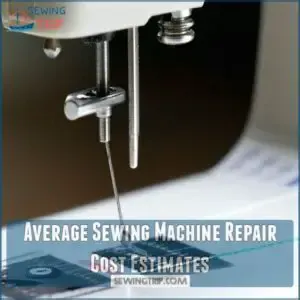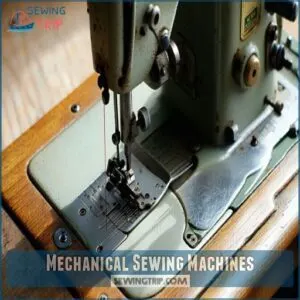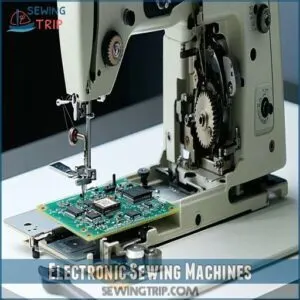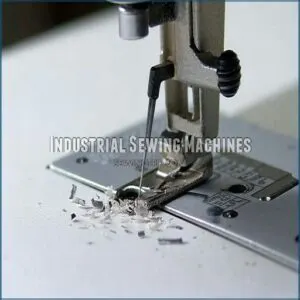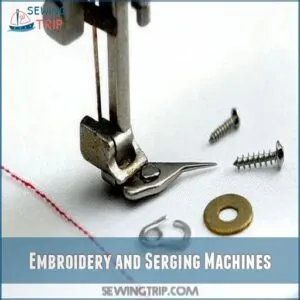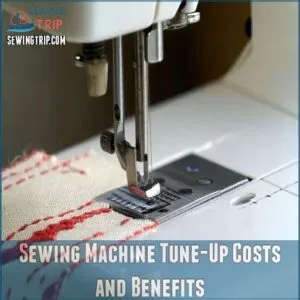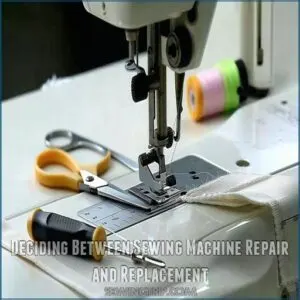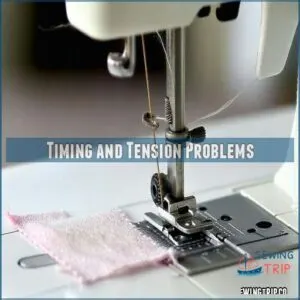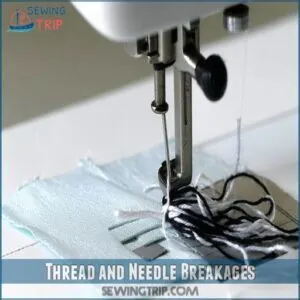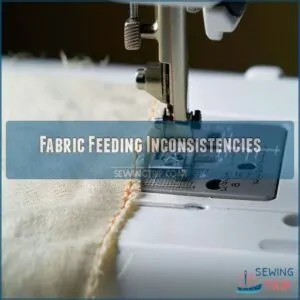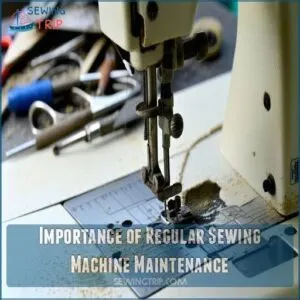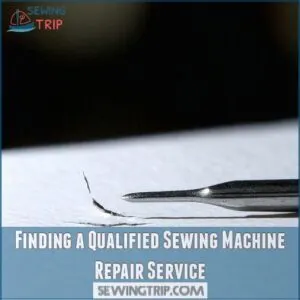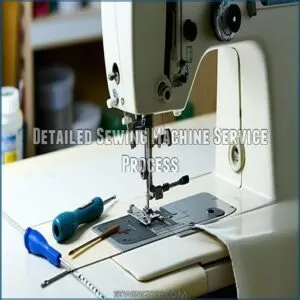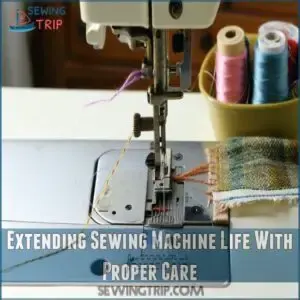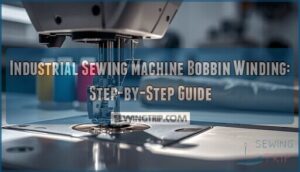This site is supported by our readers. We may earn a commission, at no cost to you, if you purchase through links.
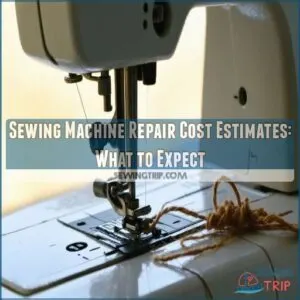 When it comes to sewing machine repair cost estimates, you can expect prices to range from $50 to $100.
When it comes to sewing machine repair cost estimates, you can expect prices to range from $50 to $100.
This can depend on various factors like the type and complexity of your machine and the expertise of the repair service.
For instance, a mechanical machine might be less expensive to fix than a high-tech electronic one.
Labor costs and the need for replacement parts can add to the bill too.
It’s wise to get a few quotes to see what fits your budget best.
In the end, regular maintenance can save you money, and maybe a headache or two!
Table Of Contents
- Key Takeaways
- Factors Affecting Sewing Machine Repair Costs
- Average Sewing Machine Repair Cost Estimates
- Types of Sewing Machines and Repair Costs
- Sewing Machine Tune-Up Costs and Benefits
- Deciding Between Sewing Machine Repair and Replacement
- Common Sewing Machine Issues and Repairs
- Importance of Regular Sewing Machine Maintenance
- Finding a Qualified Sewing Machine Repair Service
- Detailed Sewing Machine Service Process
- Extending Sewing Machine Life With Proper Care
- Frequently Asked Questions (FAQs)
- Conclusion
Key Takeaways
- You’ll find that sewing machine repair costs typically range from $50 to $100, influenced by your machine type, the complexity of the repair, and labor costs.
- Regular maintenance, including cleaning and lubrication, helps prevent costly repairs and keeps your machine running smoothly.
- When deciding between repair and replacement, consider if the repair costs exceed 75% of the machine’s value; if so, replacement might be more cost-effective.
- Seeking multiple repair estimates and checking online reviews ensures you find a reliable and skilled repair technician.
Factors Affecting Sewing Machine Repair Costs
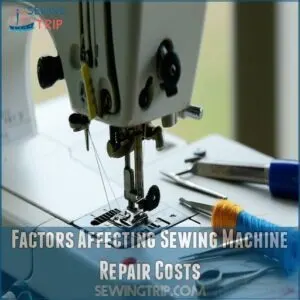
When you’re figuring out sewing machine repair costs, several factors come into play, like machine type and complexity, your location, and the repairman’s expertise.
The extent of damage or the specific repairs needed also heavily influence the final bill.
Machine Type and Complexity
Different sewing machine types each bring unique repair challenges.
While a trusty old mechanical machine might need simple fixes, newer electronic models often require more intricate solutions, and in some cases, may be impossible to fix due to missing parts or software issues.
The age and complexity of your machine can greatly impact repair costs.
Specific features, like computerized components or multiple needles, can also drive up the price.
Knowing your machine’s intricacies helps anticipate repair estimates and navigate costs effectively.
Location and Repairman’s Expertise
A sewing machine repair can shift in cost based on where you live and who’s handling the fix.
Imagine hiring a highly skilled sewing machine repair technician: in bustling urban areas, rates might climb due to local market rates, while a skilled repairman’s reputation can also influence pricing.
Before searching for a repair technician, you can browse online for sewing machine repair cost estimates and products at websites like Sewing Machine Repair Products.
Expertise specialization adds value; after all, it’s not just any service—it’s your trusty machine at stake.
Extent of Damage or Needed Repairs
The extent of damage heavily influences sewing machine repair costs.
Repair complexity varies greatly; here’s a quick lowdown:
- Common repairs like thread tension or timing adjustments are cheaper.
- DIY fixes can save you bucks, especially if you’re handy.
- Major issues—like motor or electronic failures—require a costlier intervention.
- Repair vs. replace decisions hinge on damage severity and machine value.
Understanding these factors helps manage repair estimates.
Average Sewing Machine Repair Cost Estimates
You’ve explored what affects repair costs, but what can you actually expect to pay?
Sewing machine repair cost estimates range from $75 to $180 for minor fixes, like spring replacements.
For a more detailed look at average repair costs, consider checking out average sewing machine repair resources.
A basic tune-up typically costs between $75 and $100.
More advanced repairs, like those for electronic models, might set you back an extra $60 to $150.
For specific brands, such as Singer machines in California, expect a baseline around $85.
Understanding these variations can empower you to make informed choices and potentially save money down the line.
Types of Sewing Machines and Repair Costs
Understanding the type of sewing machine you own is key to budgeting for repairs.
Repair costs vary widely depending on whether you have a simple mechanical model or a complex computerized machine.
So let’s explore those differences.
Mechanical Sewing Machines
Mechanical sewing machines have a fascinating history, often celebrated for their durability and charm.
But when issues arise, what should you expect regarding repair costs?
Regular maintenance, including tasks like cleaning and lubricating moving metal parts, can go a long way in preventing costly repairs, as outlined in the Sewing Machine Maintenance.
Basic tune-ups could be around $75 to $100.
Vintage machine repairs might cost more.
Common issues include tension adjustments.
Mechanical vs. electronic differences impact costs.
Regular maintenance helps prevent expensive repairs.
Electronic Sewing Machines
Not all repairs are equal in terms of electronic sewing machines.
Brands like Elna, Pfaff, and Bernina might require specialized attention.
Repairing electronic sewing machine errors can cost anywhere from $60 to $150 more than mechanical models.
Regular electronic sewing machine maintenance helps, but parts are pricier.
Always check sewing machine repair service reviews nearby for accurate sewing machine repair cost estimates.
Industrial Sewing Machines
When dealing with industrial sewing machines, repair costs can climb as high as $5,000.
While unnerving, these figures reflect the complexity and durability typical of industrial brands.
Parts alone might range from $16 to $148.
Regular maintenance is essential; without it, troubleshooting becomes frequent.
At a sewing machine repair shop, labor costs can quickly add up, affecting the total repair bill.
Embroidery and Serging Machines
Embroidery and serging machines can be tricky and costly to fix. Serger repair costs might start at $240, while embroidery machine repair may go higher due to their complexity and need for specialized parts.
To save on sewing machine repair prices, follow serger maintenance tips and explore different embroidery machine types.
Remember, quality care reduces visits to sewing machine repair services.
Sewing Machine Tune-Up Costs and Benefits
Keeping your sewing machine in top condition with regular tune-ups can save you money on costly repairs and guarantee smooth, reliable performance.
Tune-ups typically cost between $75 and $100, offering valuable benefits like improved stitch quality and extended machine life.
Tune-Up Services and Inclusions
You’ve gotta keep your sewing machine running smoothly, and that’s where tune-up services come in.
Think of it like a doctor’s check-up for your trusty sewing companion.
The service includes cleaning, oiling, tension adjustments, and even looks at timing issues. It’s like giving your machine a mini-makeover.
Often, parts are covered and warranties are checked.
And yes, understanding the sewing machine tuneup cost helps in planning.
Cost Savings With Regular Tune-Ups
Regular tune-ups are your secret weapon against hefty sewing machine repair bills.
Think of it as preventative maintenance—a small investment now saves you big later.
A well-maintained machine runs smoothly, avoiding costly repairs.
This cost-benefit analysis shows that regular servicing pays off.
You’ll spend less on sewing machine repair overall, maximizing your machine’s lifespan.
It’s a win-win!
Frequency of Tune-Ups for Optimal Performance
Keeping your sewing machine in tip-top shape means sticking to a regular tune-up schedule.
Ideally, aim for these intervals to enhance performance and minimize repair costs:
- Heavy users: Every 6 months for those sewing frequently or using heavyweight fabrics.
- Moderate users: Annually, especially if sewing is a seasonal hobby.
- Light users: Every 18–24 months suffices.
- Specific issues: Address unusual sounds or stitches promptly.
Deciding Between Sewing Machine Repair and Replacement
When deciding whether to repair or replace your sewing machine, consider its value, condition, and your sewing needs.
If repairs cost more than 75% of what you paid or the machine doesn’t meet your current demands, replacement might make more sense.
Assessing Machine Value and Condition
After exploring tune-up benefits, let’s consider your sewing machine’s value.
Think of it as looking at an old car—consider the machine age, purchase history, and any previous repairs.
Cosmetic wear mightn’t matter if overall functionality shines.
A general rule of thumb is to consider repair costs, such as a simple tune-up costing between sewing machine tune-up costs.
Weigh the sewing machine repair cost against its worth.
If repair estimates near, say, half the machine’s price, it might be time to rethink your strategy.
Evaluating Sewing Needs and Habits
Understanding your sewing habits sheds light on whether to repair or replace a machine.
Is your machine cutting it for your fabric types and project complexity?
Consider these questions to pinpoint your needs:
- How often do you sew?
- Do advanced features entice you?
- Is the repair budget aligned with sewing machine repair cost estimates?
- Does the machine match your skill progression?
These guide your decision.
Considering Relearning Curve With New Machine
You’ve figured out your needs, now think about the learning curve with a new machine.
New features and stitches can feel like learning a new language.
Balancing the time commitment and cost of classes with the allure of updated sewing machine models is key.
Old habits might die hard, but exploring new brands could be exciting.
Consider what suits your style best, repair or replace?
Common Sewing Machine Issues and Repairs
When your sewing machine starts acting up, it could be due to common issues like timing and tension problems, thread and needle breakages, or fabric feeding inconsistencies.
Understanding these problems and their typical repair costs can help you keep your machine running smoothly without unexpected expenses.
Timing and Tension Problems
Dealing with a temperamental sewing machine? Timing and tension problems are common culprits.
Troubleshooting these issues can save you money on repair estimates. Here’s what to check:
- Incorrect bobbin winding.
- Improper needle placement.
- Worn or damaged timing belt.
- Tension dial miscalibration.
Seeking expert advice might be necessary for complex timing repair, but many DIY solutions exist.
Prevention tips include regular cleaning and lubrication.
Thread and Needle Breakages
Thread and needle breakages can stop your sewing project cold.
It’s usually about needle size, thread type, or tension issues.
Check for mismatches; a heavy thread on a fine needle is asking for trouble.
Or, it could be bobbin problems sneaking in.
Here’s a quick table for clarity:
| Issue | Cause | Solution |
|---|---|---|
| Needle breaks | Wrong size | Match needle to fabric |
| Thread breaks | Tension too tight | Adjust tension settings |
| Frequent breaks | Cheap thread | Use quality thread |
Managing these can save you frustration and unnecessary sewing machine repair cost estimates.
Fabric Feeding Inconsistencies
A snag in fabric feeding can feel like hitting a bump in your creative road. Whether it’s bobbin tension acting up or foot pressure not quite right, these issues often lead to jagged stitching or jammed material.
- Check needle: Sometimes, a bent or dull needle causes the snag.
- Foot pressure: Adjust to match fabric types for smoother feed.
- Bobbin tension: Make sure it’s balanced to prevent snarls.
Importance of Regular Sewing Machine Maintenance
Regular maintenance is essential for your sewing machine because it keeps everything running smoothly, preventing expensive repairs down the line.
By following cleaning and lubrication best practices and managing tension and timing adjustments, you guarantee your sewing machine stays in top condition, ready to handle any project.
Cleaning and Lubrication Best Practices
Dust bunnies don’t belong in your sewing machine.
Regular cleaning and lubrication are essential to keep it running smoothly.
To establish a routine, consider creating a regular cleaning schedule, including weekly cleaning of the bobbin case and hook area.
Use the right sewing machine oil types and cleaning tools for effective maintenance.
Schedule cleaning to coincide with your sewing projects, ensuring lint removal isn’t overlooked.
This basic machine service saves on repair costs by preventing issues.
Keep a consistent maintenance schedule to extend your machine’s lifespan and reduce repair needs.
Tension and Timing Adjustments
After mastering cleaning and lubrication, let’s talk about tensions and timing.
Tension adjustments make sure stitches don’t skip a beat, like tuning a guitar. It’s all about finding the sweet spot between too tight and too loose.
Timing, on the other hand, synchronizes needle and bobbin movements. When these elements are off, it’s like your machine’s singing out of tune. Regular tune-ups keep everything harmonious.
Quick 10-Minute Cleaning Method
Getting the tension just right keeps everything humming smoothly, but here’s a quick cleaning tip to keep your sewing machine in top shape.
In just ten minutes, you can:
- Unplug and dust: Clear any lint or dust bunnies.
- Check the needle: Make sure it’s straight and sharp.
- Oil sparingly: Use machine oil on moving parts.
- Re-thread carefully: Double-check threading for smooth sewing.
Consistency here saves on those repair bills!
Finding a Qualified Sewing Machine Repair Service
Finding the right sewing machine repair person is key to getting your machine back in tip-top shape.
Check online reviews and ask friends for recommendations to find someone reliable and skilled.
Researching Local Repair Shops and Technicians
Once you’ve got your maintenance routine down, it’s smart to start checking out local sewing machine repair shops.
Consider the shop’s reputation and the experience of the technicians.
Look for pricing transparency and service guarantees to prevent surprises.
It’s helpful to search "sewing machine repair near me" to find repair services offering free estimates.
Knowing your options gives you a bit more control over repair decisions.
Checking Reviews and Referrals
Finding the right sewing machine repair service can be as easy as browsing online reviews or asking around.
Use Google Maps to check "sewing machine repair near me" and take advantage of word-of-mouth through local forums or trusted sources.
Even a quick chat with fellow sewing enthusiasts can steer you toward reputable repair shops.
Aim for those offering free estimates to keep your decisions informed and cost-effective.
Evaluating Repair Estimates and Services
After checking reviews and referrals, understanding labor costs and getting multiple quotes is wise for savvy sewing machine repair shoppers.
You can also find various products and tools related to sewing machine repair prices online, such as at sewing machine repair parts.
Look for repair shop reputation and service history.
Authorized centers often provide better warranty coverage, ensuring peace of mind.
Don’t shy away from asking for free estimates; compare those carefully.
Nationwide repair services offer broader coverage but sometimes at a premium.
Evaluate these factors to make informed decisions.
Detailed Sewing Machine Service Process
Understanding the sewing machine service process helps you maintain your machine’s peak performance.
You’ll tackle cleaning, lubrication, tension adjustments, and even timing tests to make sure everything runs smoothly without breaking the bank.
Cleaning and Lint Removal
Dust loves to settle in your sewing machine, impacting performance and possibly causing repairs.
Regular cleaning using correct lint brush types, like soft dusting tools, prevents buildup.
Pay attention to the lint trap cleaning during your sewing machine cleaning routine.
Effective cleaning tips not only save on sewing machine repair costs but also enhance longevity.
Making this a habit helps keep your sewing machine in great condition.
Lubrication and Tension Adjustments
Picture yourself learning the ins and outs of sewing machine maintenance. Lubrication and tension adjustments are essential for a smooth ride.
Keep these pointers in mind:
- Use the right sewing machine oil types for smooth operation.
- Check oiling frequency to avoid drips and stains.
- Invest in tension adjustment tools for quick fixes.
Mastering these spots helps cut down your sewing machine repair costs and keeps you sewing happily.
Timing Adjustments and Testing
Precise timing is essential; a slight misalignment throws your stitches off. Let’s fine-tune your machine’s timing.
| Step | Action | Expected Result | Common Errors | DIY vs. Professional |
|---|---|---|---|---|
| 1. Check Timing | Observe stitch formation during test stitching. | Even, consistent stitches | Uneven stitches, skipped stitches | Easily checked DIY; repair may need pro |
| 2. Adjust | Use adjustment screws (refer to your manual). | Improved stitch quality | Over-tightening, stripping gears | Requires pro knowledge and tools |
| 3. Test Again | Repeat test stitching, making minor adjustments. | Perfect stitches | Incorrect bobbin, bent needle | Simple testing is DIY; fixes usually require a pro |
| 4. Repeat | Continue until stitches are consistent and even. | Smooth, reliable sewing performance | Improper lubrication, bent hook | Professionals guarantee precision |
| 5. Final Test | Sew a test seam with your usual fabric. | No skipped stitches, thread breakage | Ignoring manual, forcing adjustments | A professional guarantees machine health |
Remember, slight adjustments make a big difference!
Extending Sewing Machine Life With Proper Care
Just like a car needs regular check-ups, your sewing machine benefits from consistent care.
Give it a little TLC with routine cleaning tips, including essential sewing machine maintenance tools, and avoid costly repair pitfalls.
Keep dust bunnies at bay with quick sweeps and a regular oiling routine for smooth operation.
If your machine starts whispering complaints, check a troubleshooting guide before calling the pros.
Remember, a stitch in time saves nine. This approach helps you keep sewing joyfully without unexpected trips to sewing machine repair technicians.
Frequently Asked Questions (FAQs)
How much does a sewing machine repair cost?
If your sewing machine’s starting to act like a rebellious teenager, repairs can range from $75 for a tune-up to around $180 for minor fixes.
For electronic models, anticipate an added cost of $60 to $
Where can I get a sewing machine repaired?
You can get your sewing machine repaired at local sewing or quilting shops, craft stores with repair services, or authorized service centers for your machine’s brand.
Check online reviews to find a reliable and skilled technician.
How much does a sewing machine tune-up cost?
Ironically, that "simple" tune-up for your sewing machine can set you back anywhere from $75 to $
Think of it like your machine’s spa day, ensuring it hums along smoothly without unexpected breakdowns.
Maintenance matters!
How much does a sewing machine repair school cost?
Sewing machine repair school costs vary widely. Tuition depends on program length, location, and certifications offered. Expect to spend anywhere from a few hundred to several thousand dollars.
Should I repair or replace my sewing machine?
Imagine this: you’re at a crossroads, an old machine in one hand, and a shiny new model in the other.
If repair costs exceed 75% of its value, consider replacing it for better performance and features.
How much does embroidery machine repair cost?
Embroidery machine repairs generally start at $240 but can vary greatly depending on the specific issue and machine complexity.
High-end multi-needle models may cost more, reflecting both parts and labor expenses, so always get a quote first.
What is the average cost to fix a sewing machine?
Fixing your sewing machine can feel like finding a needle in a haystack, but typically it costs between $75 to $
Factors like machine type and repair complexity really needle into the final amount.
How much to service a sewing machine?
Servicing a sewing machine typically costs between $75 and $
This usually covers a tune-up with cleaning and lubrication, but won’t include replacement parts.
Regular maintenance prevents costly repairs and keeps your machine running smoothly.
Is it worth having a sewing machine repaired?
If your trusty machine’s repairs don’t exceed 75% of its original cost and it’s still in good shape, it’s usually worth fixing.
Consider your sewing needs and whether it makes sense to repair or replace.
How much does it cost to restore an old sewing machine?
Restoring an old sewing machine might run you anywhere from $100 to $500, depending on its condition and complexity of the job.
It’s best to get a detailed estimate to make sure you’re not stitching up more costs than necessary.
How long does a typical repair take?
Getting your sewing machine back in tip-top shape? It usually takes a day or two, but complex repairs might need a week. Don’t fret; you’ll be stitching again soon!
Are weekend repair services available?
Weekend sewing machine repair services depend on the shop, but many offer flexible hours.
Availability is key, so it’s a good idea to call ahead and ask about availability to make sure you won’t be left in a stitch.
What warranties are offered on repairs?
Looking for a repair warranty?
Many sewing machine repair shops offer 30 to 90-day warranties, covering parts and labor.
Always ask about the warranty terms to make sure your machine’s repairs are backed by reliable support.
Can I get a free repair estimate?
You can often get a free repair estimate from sewing machine repair shops.
Many offer this service to diagnose issues before committing to repairs.
It’s best to call ahead and confirm their policy.
What are signs my machine needs servicing?
If stitches resemble tangled spaghetti or your machine sounds like an off-key band, it’s time for servicing.
Frequent thread breaks, uneven stitches, or sluggish speed are clear alarms your machine’s due for a check-up.
Conclusion
When faced with sewing machine repair cost estimates, think of it as investing in your creative journey.
Understanding factors like machine type, repair needs, and maintenance costs can help you make savvy choices.
Whether you’re dealing with a mechanical model or a complex electronic one, regular upkeep can save money and extend your machine’s life.
Choose wisely between repair and replacement to keep your sewing projects smooth and stress-free.
Embrace proactive care and find reliable repair services for lasting performance.

